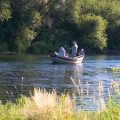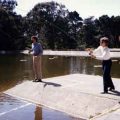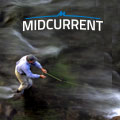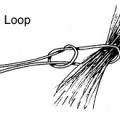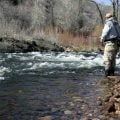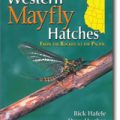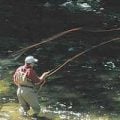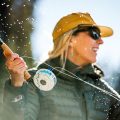Brant Oswald
Brant Oswald has worked in nearly every segment of the fly fishing industry–as a commercial fly tier, fishing school instructor/director for both Orvis and the Mel Krieger schools, travel consultant, fly shop manager, and now as a guide and outfitter in Livingston, Montana. Brant has written for The Angler’s Journal, Wild Trout Journal, Big Sky Journal, Fly Fishing Retailer, Rod & Reel, and Wild on the Fly. He currently contributes to MidCurrent.
Author Articles
Small Streams Under Big Skies
EVEN THOUGH I live in a lightly populated state in the Rockies, a lot of my strategy as a trout guide is not about the traditional fishing skills of reading water and fly selection and presentation. Instead, it revolves around dealing with fishing pressure—finding less-fished water, picking a stretch of river or scheduling the day to avoid as many other...
You Can Do Something About the Weather
ANGLING TACTICS are determined by any number of factors, but weather is always one of the most important. When I think of the influences of weather conditions on a fishing situation, I am reminded of a customer who, a few seasons ago, walked into the Livingston, Montana fly shop where I worked. It was one of those days that would frustrate any angler or...
Montana Water Types and Techniques
THROUGH THE FRONT WINDOWS of the fly shop, I could see the motor home turn off the highway, crunch across the gravel of the parking lot, and roll to a stop. After a minute or two, two tourists, a man in his seventies and a boy of about ten, emerged, walked hesitantly throught the open door, and made their way to the front counter. The old man stuck his chin...
The Mechanics of Accurate Casting
IN OUR FIRST PIECE on casting accuracy, we discussed different types of casting accuracy (distance accuracy vs. left and right accuracy), some of the fishing situations that demand them, and some of the fishing skills that relate to casting accuracy. In this article, we will discuss some of the actual casting techniques that contribute to accuracy. In...
Midge Fishing in Paradise
FOR MANY ANGLERS, the mere mention of midge fishing strikes terror into their hearts. The thought of nearly invisible flies, ultra-thin tippets, and selective trout conjures up images of frustrating fishing and few fish brought to hand. But for the visitor to the spring creeks and stillwaters in the Paradise Valley of Montana, midge fishing may produce some...
Rigging Yarn and Dry Fly Indicators
IN THE FIRST PART of this article on strike indicators, I discussed the types of indicators available for spring creek and tailwater angling, and I identified yarn and dry fly indicators as two of the best methods. Below I have detailed several of the best ways to rig each type of indicator. Rigging Yarn Indicators I should note that there are now several...
Strike Indicators
MANY OF US are drawn to spring creeks and tailwaters because these rich environments produce heavy hatches of aquatic insects and offer the angler consistent and predictable dry fly fishing. On the other hand, the spring creek angler encounters periods—in almost any given day of fishing and especially over the course of a full season—when there is no...
Review: "Western Mayfly Hatches"
THE 1970s and early 1980s ushered in a new era of information and angling literature about insect hatches and imitative fly patterns. As a teenager in southern Idaho, trying to figure out how to fool the rainbows of Silver Creek, Selective Trout became my bible for several summers. I collected and studied the classic bug books that followed: Hatches...
Bluelining Under the Big Sky
Even though I live in a lightly populated state in the Rockies, a lot of my strategy as a trout guide is not about the traditional fishing skills of reading water and fly selection and presentation. Instead, it revolves around dealing with fishing pressure–finding less-fished water, picking a stretch of river or scheduling the day to avoid as many other...
Fly Casting: The Importance of Casting Accuracy
IN DIFFICULT FISHING SITUATIONS on spring creeks and tailwaters, anglers often pin their hopes for success on a fly box full of imitative patterns and advanced presentation skills like stack mending and curve casting. This makes sense, since the ability to match the hatch and present the fly with minimal drag are often what separates this "technical...


